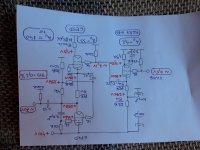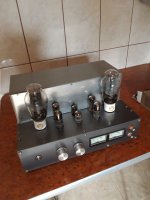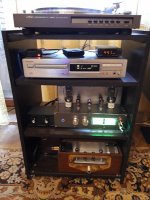I will order and use Rod Coleman's new shunt cascode kit. I'm not sure if it is ready yet or not.
I have some new boards, but the parts supply has disappeared before I could stock up. My apologies - I am preparing a revised circuit, returning to all-discrete, for ease of procurement!
I've tried to wrap my head around how the mu-stage could look like with a differential input to drive a 300B output stage. I don't yet totally understand everything that I'm doing. I'll post this here and maybe one of you is kind enough to point out all the things that are wrong with it.
View attachment 992049
I think it is worth building it as a real circuit, and measuring it up.
One deception that SPICE always plays on us is to give results that you would get if all the triodes (& transistors..) were exact matches. This is an important consideration for your circuit, as the two halves of the differential pair will degrade the overall performance, with real-world mismatch.
But you can reduce the errors by adding small-value resistors between the CCS tail, and each cathode of U4a and U4b. Try the sims again with say, 68Ω and 100Ω. higher values give better match, but lower gain; so as always you must find the right compromise.
Last edited:
I think it is worth building it as a real circuit, and measuring it up.
One deception that SPICE always plays on us is to give results that you would get if all the triodes (& transistors..) were exact matches. This is an important consideration for your circuit, as the two halves of the differential pair will degrade the overall performance, with real-world mismatch.
But you can reduce the errors by adding small-value resistors between the CCS tail, and each cathode of U4a and U4b. Try the sims again with say, 68Ω and 100Ω. higher values give better match, but lower gain; so as always you must find the right compromise.
That is good advice for sure. Thanks.
Before getting into real-world prototyping, since this is the first time I'm not going with a fully pre-made design, I wanted to get a few eyes on the starting point (just being the driver stage in this case) to check whether there obvious problems with what I've cooked up so far...
Also tube type recommendation would be interesting.
I have some new boards, but the parts supply has disappeared before I could stock up. My apologies - I am preparing a revised circuit, returning to all-discrete, for ease of procurement!
Can you please let me know when revised circuit are ready? I will order.
If the results are the ones listed, they are poor.
I think you have to change the approach to find the right driver for 300B
And the circuit you post is not the right way.
Walter
Attachments
- Home
- Amplifiers
- Tubes / Valves
- Looking for a 300b SE design


